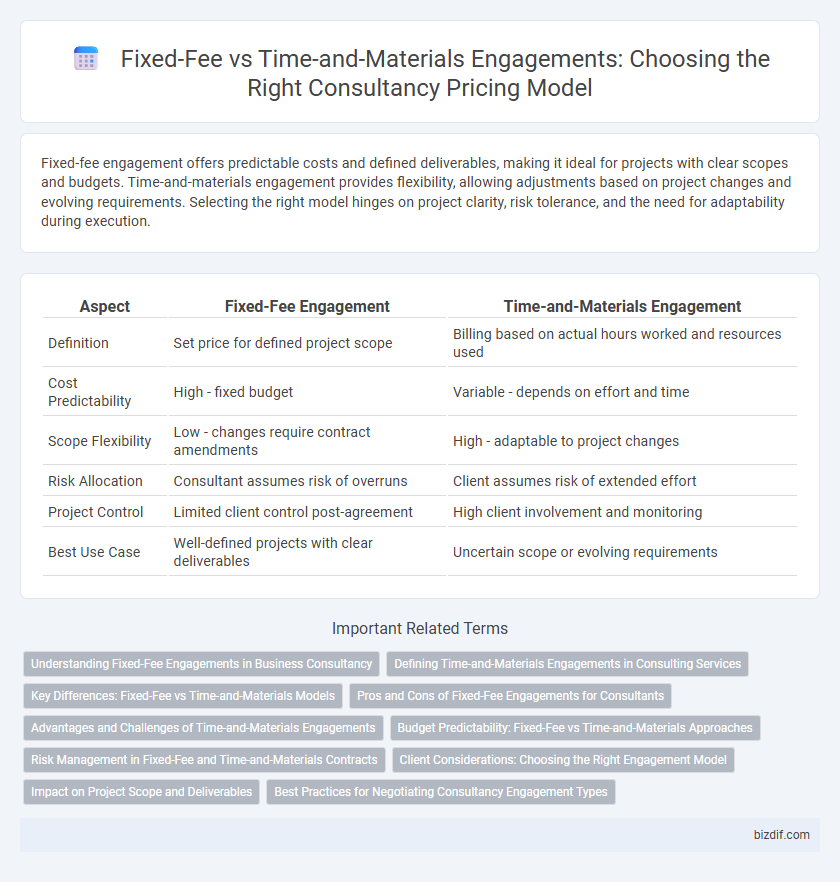Fixed-fee engagement offers predictable costs and defined deliverables, making it ideal for projects with clear scopes and budgets. Time-and-materials engagement provides flexibility, allowing adjustments based on project changes and evolving requirements. Selecting the right model hinges on project clarity, risk tolerance, and the need for adaptability during execution.
Table of Comparison
| Aspect | Fixed-Fee Engagement | Time-and-Materials Engagement |
|---|---|---|
| Definition | Set price for defined project scope | Billing based on actual hours worked and resources used |
| Cost Predictability | High - fixed budget | Variable - depends on effort and time |
| Scope Flexibility | Low - changes require contract amendments | High - adaptable to project changes |
| Risk Allocation | Consultant assumes risk of overruns | Client assumes risk of extended effort |
| Project Control | Limited client control post-agreement | High client involvement and monitoring |
| Best Use Case | Well-defined projects with clear deliverables | Uncertain scope or evolving requirements |
Understanding Fixed-Fee Engagements in Business Consultancy
Fixed-fee engagements in business consultancy involve agreeing on a predetermined price for the completion of specific projects or deliverables, providing clients with clear budget expectations and minimizing financial risk. This pricing model incentivizes consultants to efficiently manage resources and timelines while delivering agreed-upon outcomes. Fixed-fee contracts are particularly beneficial for well-defined projects where scope, objectives, and deliverables are clearly outlined upfront.
Defining Time-and-Materials Engagements in Consulting Services
Time-and-Materials engagements in consulting services involve billing clients based on actual hours worked and resources utilized, providing flexibility to accommodate changes in project scope. This model is ideal for complex or evolving projects where precise deliverables and timelines are uncertain. Consultants track labor hours, materials, and expenses, ensuring transparent billing aligned with the ongoing effort and resource consumption.
Key Differences: Fixed-Fee vs Time-and-Materials Models
Fixed-fee engagement provides a predetermined project cost, ensuring budget predictability and typically suits well-defined scopes. Time-and-materials engagement charges based on actual hours worked and resources used, offering flexibility for projects with evolving requirements. The key difference lies in risk allocation: fixed-fee places cost risk on the consultant, while time-and-materials shifts it to the client due to variable effort.
Pros and Cons of Fixed-Fee Engagements for Consultants
Fixed-fee engagements offer consultants predictable revenue and clear project scope, reducing billing disputes and enabling efficient resource allocation. However, fixed fees can pose risks if project requirements expand or unforeseen challenges arise, potentially leading to undercompensation and increased workload. Consultants benefit from fixed-fee models when project deliverables are well-defined and timelines are stable, but may face financial exposure with ambiguous or evolving client needs.
Advantages and Challenges of Time-and-Materials Engagements
Time-and-materials engagements offer flexibility in project scope and adaptability to changing client requirements, enabling consultants to address unforeseen challenges effectively. This model promotes transparent billing based on actual hours worked and resources utilized, enhancing client trust through detailed accountability. Challenges include potential cost overruns and less predictable budgets, requiring diligent project management and communication to align expectations and control expenses.
Budget Predictability: Fixed-Fee vs Time-and-Materials Approaches
Fixed-fee engagements offer greater budget predictability by setting a predetermined cost for the entire consultancy project, minimizing the risk of cost overruns. Time-and-materials engagements provide flexibility to accommodate evolving project scopes but often result in variable expenses that complicate budget forecasting. Choosing between these models depends on the project's scope clarity and the client's tolerance for financial uncertainty.
Risk Management in Fixed-Fee and Time-and-Materials Contracts
Fixed-fee engagements transfer more financial risks to the consultancy, as project scope changes or delays must be managed within the agreed-upon budget, necessitating precise risk assessments and contingency planning. Time-and-materials contracts shift the risk primarily to the client, who bears the cost of potential inefficiencies, scope expansions, or prolonged timelines, requiring transparent tracking and frequent communication to mitigate budget overruns. Effective risk management in both contract types hinges on clear scope definitions, frequent progress evaluations, and adaptive resource allocation to balance cost control and project flexibility.
Client Considerations: Choosing the Right Engagement Model
Clients should evaluate project scope clarity and budget flexibility when selecting between Fixed-Fee and Time-and-Materials engagements; fixed-fee suits well-defined projects with predictable outcomes, ensuring cost certainty. Time-and-Materials engagement benefits projects with evolving requirements, offering adaptability but requiring transparent tracking and monitoring to control costs. Strategic alignment with business goals and risk tolerance guides the optimal choice for successful consultancy collaboration.
Impact on Project Scope and Deliverables
Fixed-fee engagements provide a clearly defined project scope and deliverables, ensuring budget predictability but limiting flexibility to accommodate scope changes. Time-and-materials engagements allow for dynamic adjustments to project scope and deliverables, supporting evolving requirements but potentially increasing overall costs. Choosing between these models impacts resource allocation, client expectations, and project risk management in consultancy engagements.
Best Practices for Negotiating Consultancy Engagement Types
Successful negotiation of consultancy engagement types hinges on clearly defining project scope when opting for fixed-fee contracts to mitigate scope creep and ensure predictable budgeting. In time-and-materials engagements, establishing transparent tracking and reporting mechanisms safeguards against overbilling and aligns consultant incentives with project goals. Leveraging precise communication and detailed agreements tailored to client requirements enhances trust and optimizes delivery outcomes in both engagement models.
Fixed-Fee Engagement vs Time-and-Materials Engagement Infographic

 bizdif.com
bizdif.com